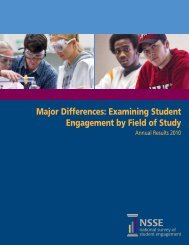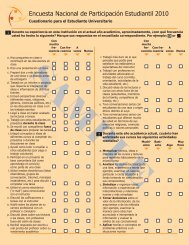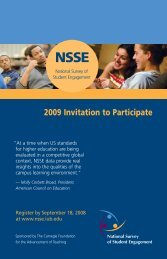Conceptual Framework and Overview of Psychometric Properties
Conceptual Framework and Overview of Psychometric Properties
Conceptual Framework and Overview of Psychometric Properties
You also want an ePaper? Increase the reach of your titles
YUMPU automatically turns print PDFs into web optimized ePapers that Google loves.
magnitude <strong>of</strong> the mode coefficients were highenough to be <strong>of</strong> practical importance towarrant attention. Finally, we applied poststratificationweights at the student-level forall survey items to minimize nonresponse biasrelated to sex <strong>and</strong> enrollment status.We analyzed the Web-only <strong>and</strong> Web-optionresults separately against paper as shown inTable 5 by Model 1 (Web-only) <strong>and</strong> Model 2(Web-option) against paper. We comparedWeb-only against Web-option in Model 3.For 39 <strong>of</strong> the 67 items, the unst<strong>and</strong>ardizedcoefficients for Model 1 favored Web-onlyover paper. For Model 2, 40 <strong>of</strong> the 67 itemsshowed statistically significant effectsfavoring the Web option over paper. Incontrast, there are only 9 statisticallysignificant coefficients that are morefavorable for paper over Web in Models 1 <strong>and</strong>2 combined. Model 3 reveals that there arerelatively few statistically significantdifferences between the two Web-basedmodes.The effect sizes for most comparisons in bothModel 1 <strong>and</strong> Model 2 are not large --generally .15 or less, with a few exceptions.Interestingly, the largest effect sizes favoringWeb over paper were for the three computerrelateditems: “used e-mail to communicatewith an instructor” (EMAIL), “used anelectronic medium to discuss <strong>of</strong> complete anassignment” (ITACADEM), <strong>and</strong> self-reportedgains in “using computers <strong>and</strong> informationtechnology” GNCMPTS).These models take into account many student<strong>and</strong> school characteristics. However, theresults for items related to computing <strong>and</strong>information technology might differ if a moredirect measure <strong>of</strong> computing technology atparticular campuses was available. That is,what appears to be a mode effect mightinstead be due to a preponderance <strong>of</strong> Webrespondents from highly Awired@ campusesthat are, in fact, exposed to a greater array <strong>of</strong>computing <strong>and</strong> information technology.On balance, responses <strong>of</strong> college students toNSSE 2000 Web <strong>and</strong> paper surveys showsmall but consistent differences that favor theWeb. These findings, especially for itemsunrelated to computing <strong>and</strong> informationtechnology, generally dovetail with studies insingle postsecondary settings (Layne,DeCrist<strong>of</strong>oro, & McGinty, 1999; Olsen,Wygant, & Brown, 1999; Tomsic, Hendel, &Matross, 2000). This said, it may bepremature to conclude that survey modeshapes college students= responses. First,while the responses slightly favor Web overpaper on a majority <strong>of</strong> items, the differencesare relatively small. Second, only itemsrelated to computing <strong>and</strong> informationtechnology exhibited some <strong>of</strong> the largesteffects favoring Web. Finally, for specificpopulations <strong>of</strong> students mode may havedifferent effects than those observed here.In auxiliary multivariate analyses, we foundlittle evidence for mode-age (net <strong>of</strong>differential experiences <strong>and</strong> expectationsattributable to year in school) or mode-sexinteractions, suggesting that mode effects arenot shaped uniquely by either <strong>of</strong> thesecharacteristics.Additional information about the analysis <strong>of</strong>mode effects is available in the NSSE 2000Norms report (Kuh, Hayek et al., 2001) <strong>and</strong>from Carini, Hayek, Kuh, Kennedy <strong>and</strong>Ouimet (in press). A copy <strong>of</strong> the Carini et al.paper can is on the NSSE website. We willcontinue to analyze NSSE data in future yearsto learn more about any possible mode effects.<strong>Framework</strong> & <strong>Psychometric</strong> <strong>Properties</strong>Page 18 <strong>of</strong> 26



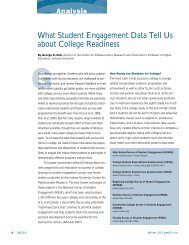

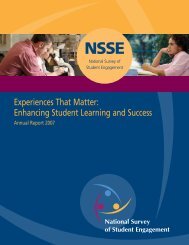
![Cuestionario para el Estudiante Universitarioâ[consent] - NSSE](https://img.yumpu.com/41728892/1/190x245/cuestionario-para-el-estudiante-universitarioaconsent-nsse.jpg?quality=85)
